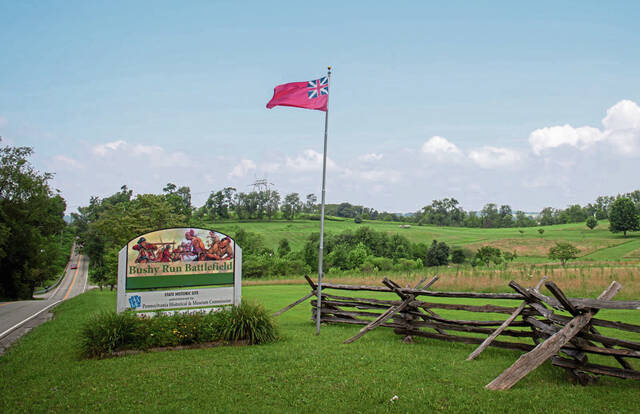Editorial: Name change at Bushy Run Battlefield is about authenticity
Imagine that Pennsylvania was not named by Charles II after founder William Penn’s father, a British admiral.
What if, instead of christening it in the Latin for “Penn’s Woods,” the king listened to one of the admiral’s most bitter enemies? What if the same happened with William Pitt, the Earl of Chatham and prime minister to George III?
Today, Pittsburgh could be Cheat’em, the second largest city in Roguesylvania.
Instead, the city and state are known by the two men’s actual names — without commentary on their lives or personality traits, good or bad. If you want to know more about the admiral or the statesman, you will have to crack a history book and decide for yourself.
Bushy Run Battlefield in Penn Township will be making a change during its upcoming reenactment. The event replays the 1763 engagement between British troops and Native American fighters during Pontiac’s War — a three-year conflict that occurred between the French and Indian War and the American Revolution.
There is a small hill behind the Bushy Run museum. It has an informal name, though few people are really aware. It is called Iroquois Hill.
For many non-native Americans, if they know the name “Iroquois,” it is only as a tribal name. They might identify it the same way they recognize Apache, Comanche, Navajo or Eskimo.
The problem is that none of those names are the names those tribes used for themselves. Apache and Comanche mean “enemy” in the tongues of other tribes who used the word to identify the groups to the English or Spanish. The word Navajo is a Spanish corruption of a Ute word, making it a complicated misinterpretation.
While some stories said Eskimo meant “eater of raw meat,” it now appears to be a garbled French term for making snowshoes. It might not be insulting, but it is inaccurate, as it has become a generic reference to the Inuit and the Yupik tribes.
And what about the Iroquois? It references the confederacy of six tribes that occupied parts of the Northeast, including Pennsylvania. But the name is not their own. It means “black snakes” in Huron, a tribe allied with the French at the time. According to Leon Sam Briggs, a Tonawanda Seneca man who consults with Bushy Run, the reference is “lower than a snake’s belly.”
The group of tribes call themselves Haudenosaunee, or “people of the longhouse.” Most indigenous groups — including all those mentioned above — describe themselves as some variation of “the people.”
On Saturday, a rededication ceremony will change Iroquois Hill to Haudenosaunee Hill.
Some might call this woke. There might be cries of political correctness. People had similar feelings about Fox Chapel and O’Hara removing the word “squaw” — a pejorative term for a native woman — from landmark names. There have been those who said changing the names of athletic teams like the Washington Commanders or Cleveland Guardians erased Native Americans; President Donald Trump has called for both to be changed back.
But this renaming is not a change for change’s sake. It is an attempt to be authentic. None of us would want to have our tombstone etched with the name we were called by our worst enemy.
Remove the ads from your TribLIVE reading experience but still support the journalists who create the content with TribLIVE Ad-Free.

